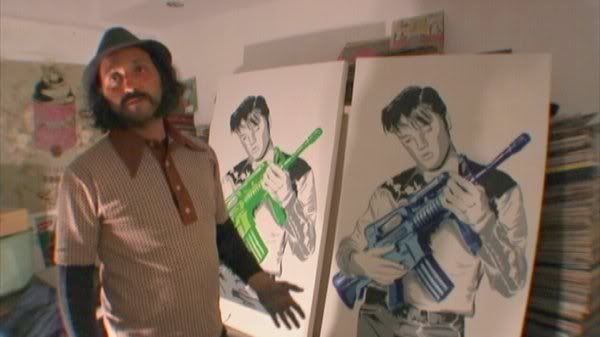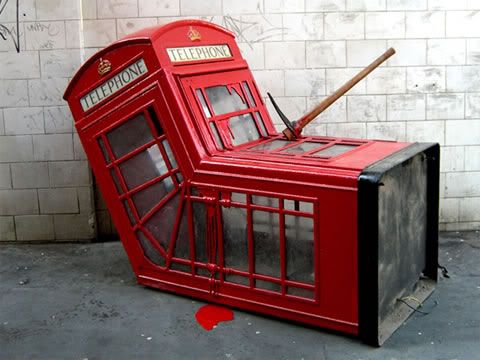Thursday, January 27, 2011
 2:17 PM |
How to Be an Artist Without Really Trying
2:17 PM |
How to Be an Artist Without Really Trying

Truth to tell, I find myself stumbling all over the place trying to write something coherent about this film I have just seen. In a way, I am struck dumb by it. It is not because the film is bad; it is because it is
very good, and perhaps my flailing has every thing to do with a conscious effort to process whatever it is about this documentary that impresses me as a work of genius. It got to me. I
think I understand it in a deeply emotional
and intellectual level, but it finally comes to me as a treacherous Chinese box: a film of so many layers, that to penetrate one is just gaining entry to another layer that leads to other layers. It playfully winds itself in unexpected ways even as we unravel it. This is the multidimensionality of Christopher Nolan's
Inception taken to the heart of the art world and given the attitude of a prankster. Why do I say that? Because in some maniacal level, the film also seems to mock me:
So you pretend to get me, eh? it says.
What a pretentious ass you are. In many ways, that feeling is exactly like being a visitor to "Barely Legal," Banksy's landmark exhibition of his street art in 2006, and getting a souvenir that says "I Can't Believe You Morons Actually Buy This Shit."
I love Banksy's
Exit Through the Gift Shop [2010] -- but the nagging question remains: what if what I'm buying is just "shit," a high concept joke? No matter. Because, divorced from all other post-modern considerations, it is actually a sincere film that (1) documents quite well the street art scene, but also (2) gives a devastating illustration of how we -- in an effort to be "in" or to be part of "cool" -- are easily taken in by so-called artists whose gifts may lie more in hype and personal showboating than in actual artistry. Pop Art has always been about skewering our unthinking allegiance to consumer culture. But in the ironic twist of eventually becoming part of that consuming culture it mocks
(galleries! agents! shows! modern art buyers!), the film shows it is much like seeing a snake eating its own tail.
Consider, for example, the scenes in this documentary where we get the ambush interviews of people who have just witnessed the unveiling of Mr. BrainWash's debut exhibit in Los Angeles. In context, we have just seen the mad hamminess of Mr. BrainWash, his "artistry" nothing more than mere supervised scanning (by other people in his employ) and re-imaging (also by other people in his employ) of iconic works already out there. His works are derivative and uninspired, with none of the wit or the intelligence of the street artists he wants to emulate. (How many times can you rip off Warhol, put a Marilyn Monroe wig on everybody from Spock to Larry King, and still be considered somebody with something worthwhile to say?) But a careless banner story in the
L.A. Weekly has already proclaimed him a new artist of grand reckoning -- hype that Mr. BrainWash has engineered himself. And so what do we get from the eventual ambush interviews? Of people fawning, just because they have been "told" to fawn. Most sputter something about the "genius" they have just seen, with some quite unsure about the artistry of most of the works in exhibition yet stammering on to confused conclusions that these works do "say something" about contemporary culture. I realize:
we are those people. We do buy shit, especially if it's wrapped in hype and is labeled "cool."
We are these people who see blatant mediocrity jazzed up in some ways in an exhibition (or in a film festival!) -- and just because it just doesn't seem to run like the usual, we immediately proclaim it as a work of utter genius. (Alas, this is much the same way people lauded Francis X. Pasion's terrible
Sampaguita, a messy soup of a film from the poverty porn factory that sadly belied his success in
Jay.)
Mr. BrainWash --
nom de guerre of the (eventually) exasperating homunculus in the center of Banksy's many-layered documentary -- is either a hoax or a living/breathing symptom of everything that is wrong about pop culture and our unthinking consumption of it. In real life, he is Thierry Guetta, a French transplant to Los Angeles and one-time vintage clothes retailer whose obsession with videotaping every minute of his life has somehow led him to become an unwitting "documentarian" of street art, just as its popularity and mystique are exploding all over the world's metropolitan centers. (Think New York, London, and Paris.) He was on the scene at the right time and the right place, his entry to this world being an accidental footage he captured of his cousin -- the French street artist Invader -- at work gluing characters from the computer game "Space Invaders" (made from colorful square tiles) all over the streets of Paris. This chance glimpse eventually leads to other street artists that Mr. Guetta eventually films -- Seizer, Neck Face, Sweet Toof, Cyclops, Dotmasters, Swoon, Buffmonster, Monsieur André, Zevs, and Shepard Fairey -- big names in this counter-culture art world that works in the shadows, always on the sly, always courting danger and legal wrangling. What fascinates us about them is that they give us works that, first of all, titillate because they work outside the normal structures of the so-called art world, but also because they are witty surprises in paint or stencil that take our ordinary physical world, and gives it a dimension that unnerves or amuses. Consider Banksy's murdered phone booth in a London alley below...

Or Ellis Gallagher's stenciled sneakers at play with shadows in New York...

One figure proves elusive, however: Banksy, the English street artist whose notoriety is exceeded only by both the unalloyed provocation of his genius and his preference to keep his identity (and process) hidden from public scrutiny. But a chance encounter eventually lets Banksy take in Mr. Guetta in confidence, allowing even the Frenchman to videotape him at work, citing the ephemeral nature of his art that cries for documentation. It's graffiti, after all, and like most graffiti, they're eventually effaced. The documentary, we are told, came about because of a challenge: Mr. Guetta has amassed years and years of footage, which he claims he is putting together into a documentary. Now the artists are wondering: when will the film be finished? Mr. Guetta hastily puts together a film he calls
Life Remote Control, an unwatchable mess that runs for more than an hour, clearly the work of a person who is not in any way a filmmaker. It is at this point, so we are told, that Banksy takes control of the footage, and turns it on Mr. Guetta. The film starts to take another direction as we follow Mr. Guetta try to become a street artist himself, but as somebody who wants to take the short cut and get right to the top -- culminating in the aforementioned exhibit, his debut Los Angeles show called "Life is Beautiful." We are finally shown the process of how a small man -- utterly talentless in every way but imbued with the implacable sense that he is, or can be, a real artist -- can make it big in the modern art world, given hype and self-promotion.
That was painful to watch. I cringed, and cringed. It all seemed so familiar. Because how many people do we know who are exactly like Mr. BrainWash? People without an eye for composition, but call themselves photographers just because they have a DSLR or know how to Photoshop? People who have no concept of mise-en-scene, but call themselves film directors because they happen to have a camera and a screenplay on standby? People who don't read, but call themselves poets because they have feelings they want to share and they can rhyme? People who have no idea of artistic space and functionality, but call themselves furniture designers because they can cobble wood into slightly interesting shapes? People who dress up in eccentric clothing, wear their hair in strange ways, and call themselves "artistes" -- but are without the slightest discipline to produce anything?
And of course, there are the people who lap all that bullshit up.
This documentary is a great meditation on that, and the artistic process -- but at the same time, it also plays as a kind of mind game knowing Banksy's reputation as a prankster. Is this film for real? Is that hooded man even Banksy? In telling the story of Mr. BrainWash, is he giving us a deep look into the world of street art, or is he mocking us the viewers as the ultimate recipient of this joke? Who knows?

Read an interview with Banksy by
All These Wonderful Things' AJ Schnack
here.
Labels: art and culture, documentaries, film, rants
[0] This is Where You Bite the Sandwich
GO TO OLDER POSTS
GO TO NEWER POSTS

















 2:17 PM |
How to Be an Artist Without Really Trying
2:17 PM |
How to Be an Artist Without Really Trying



